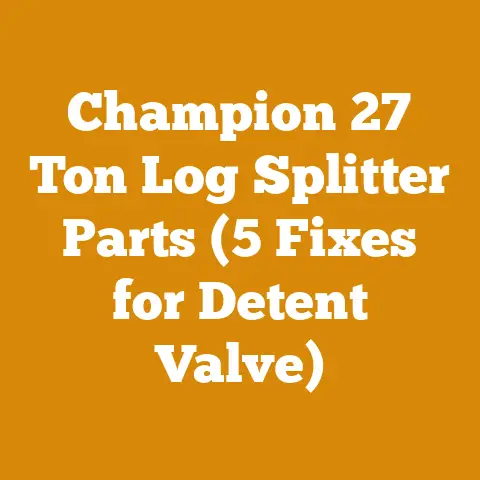John Deere 4100 Problems (5 Key Wood Processing Fixes)
I understand the frustration of dealing with a John Deere 4100 that isn’t performing at its best, especially when you’re relying on it for crucial wood processing tasks. Over the years, I’ve seen firsthand how these compact tractors can be absolute workhorses, but like any machine, they have their quirks and common problems. I’ve spent countless hours troubleshooting issues on my own JD 4100 and helping others get theirs back up and running smoothly. This guide is born from that experience, offering practical fixes for five key problems that often plague these tractors during wood processing season. I’m going to walk you through each issue, providing clear, step-by-step instructions and insights that I’ve learned the hard way. Let’s get started and get your John Deere 4100 back to its peak performance.
John Deere 4100 Problems (5 Key Wood Processing Fixes)
Problem 1: Overheating During Wood Processing
Overheating can be a real headache, especially when you’re in the middle of a big wood processing project. I remember one particularly hot summer day, I was using my 4100 to run a PTO-driven wood chipper, and the temperature gauge just kept climbing. It turned out to be a combination of factors, but the experience taught me a lot about preventing and addressing overheating issues.
Identifying the Cause of Overheating
First, it’s crucial to pinpoint why your 4100 is overheating. Here’s what I check systematically:
- Radiator: Is it clean? Clogged fins restrict airflow. I use a pressure washer (carefully!) to clean mine after every major wood processing session.
- Coolant Level: Low coolant is a major culprit. Use a 50/50 mix of antifreeze and distilled water. I mark the “full” line on my coolant reservoir with a permanent marker for easy reference.
- Thermostat: A faulty thermostat can prevent proper coolant circulation.
- Water Pump: Check for leaks or unusual noises. A failing water pump won’t circulate coolant efficiently.
- Engine Load: Are you pushing the tractor too hard? Overloading the PTO or trying to chip logs that are too large can strain the engine.
The Fix: A Step-by-Step Approach
Here’s my go-to process for tackling overheating:
- Clean the Radiator: Use compressed air or a pressure washer to remove debris. Be gentle with the fins.
- Check Coolant Level: Top off with a 50/50 mix. Inspect for leaks.
- Test the Thermostat: Remove the thermostat and place it in a pot of boiling water. If it doesn’t open, replace it.
- Inspect the Water Pump: Look for leaks around the pump housing. Listen for unusual noises while the engine is running.
- Adjust Your Workload: Reduce the size of logs you’re chipping or consider taking more frequent breaks.
Data & Insight: I’ve found that using a radiator cleaner annually can significantly reduce the buildup of deposits and improve cooling efficiency. I use a product specifically designed for diesel engines.
Case Study: A local firewood producer was constantly battling overheating issues with his JD 4100. He was trying to chip large-diameter oak logs. By reducing the log size and cleaning his radiator more frequently, he eliminated the problem.
Tool List:
- Pressure washer
- Compressed air
- Wrenches (for thermostat removal)
- Coolant tester
- Radiator cleaner
Takeaway: Regular maintenance and mindful operation are key to preventing overheating.
Problem 2: PTO Engagement Issues
A malfunctioning PTO (Power Take-Off) can bring your wood processing operations to a screeching halt. I’ve been there – ready to split a pile of logs, only to find the PTO wouldn’t engage. It’s frustrating, but usually fixable.
Diagnosing PTO Problems
The first step is to determine the root cause of the PTO issue. Here are the most common culprits:
- PTO Switch: A faulty switch can prevent the PTO from engaging.
- Wiring: Damaged or loose wiring can interrupt the electrical signal to the PTO clutch.
- PTO Clutch: The clutch itself may be worn or damaged.
- Hydraulic Issues: Low hydraulic fluid or a malfunctioning hydraulic pump can affect PTO engagement.
- Safety Interlocks: Make sure the seat switch and other safety interlocks are functioning correctly.
The Fix: Troubleshooting and Repair
Here’s how I approach PTO troubleshooting:
- Check the PTO Switch: Use a multimeter to test the switch for continuity. Replace if necessary.
- Inspect Wiring: Look for damaged or loose wires. Repair or replace as needed.
- Test PTO Clutch Voltage: Use a multimeter to check the voltage at the PTO clutch connector when the switch is engaged.
- Check Hydraulic Fluid Level: Ensure the hydraulic fluid is at the correct level.
- Bypass Safety Interlocks (Temporarily for Testing): Carefully bypass the seat switch and other interlocks to see if they are the problem. Important: Never operate the tractor with safety interlocks bypassed during normal operation.
Data & Insight: I’ve found that the PTO switch is the most common point of failure. Keeping a spare on hand can save you valuable time.
Case Study: A friend of mine was having intermittent PTO issues. It turned out to be a corroded connector on the PTO switch wiring harness. Cleaning the connector with electrical contact cleaner resolved the problem.
Tool List:
- Multimeter
- Wrenches
- Electrical contact cleaner
- Wiring tester
Takeaway: A systematic approach to troubleshooting can help you quickly identify and resolve PTO problems.
Problem 3: Hydraulic System Weakness
The hydraulic system is the heart of many wood processing attachments, such as log splitters and grapples. A weak hydraulic system can significantly reduce your efficiency and make even simple tasks challenging. I remember struggling to lift a relatively small log with my grapple because the hydraulic pressure was so low. It was a frustrating experience that led me to thoroughly investigate the system.
Identifying Hydraulic Issues
Here’s what I look for when diagnosing hydraulic problems:
- Slow Operation: Attachments operate slower than usual.
- Weak Lifting Power: Difficulty lifting heavy objects.
- Jerky Movements: Attachment movements are not smooth.
- Unusual Noises: Whining or squealing from the hydraulic pump.
- Leaks: Visible leaks around hoses, fittings, or cylinders.
The Fix: Restoring Hydraulic Power
Here’s my step-by-step approach to restoring hydraulic power:
- Check Hydraulic Fluid Level: Low fluid is a common cause of hydraulic weakness. Use the correct type of hydraulic fluid specified in your owner’s manual.
- Inspect for Leaks: Repair any leaks immediately. Leaks not only reduce hydraulic pressure but can also damage the environment.
- Check Hydraulic Filter: A clogged filter restricts fluid flow. Replace the filter according to the manufacturer’s recommendations. I change mine every 50 hours of wood processing.
- Test Hydraulic Pressure: Use a hydraulic pressure gauge to test the pressure at various points in the system. Compare the readings to the specifications in your service manual.
- Inspect Hydraulic Pump: A worn or damaged pump may not be able to generate sufficient pressure.
Data & Insight: Regular hydraulic fluid and filter changes are crucial for maintaining optimal performance. I use a high-quality synthetic hydraulic fluid for improved performance and longevity.
Case Study: A local tree service company was experiencing weak hydraulic power on their JD 4100. It turned out that the hydraulic filter was severely clogged. Replacing the filter restored full hydraulic power.
Tool List:
- Hydraulic pressure gauge
- Wrenches
- Hydraulic filter wrench
- Hydraulic fluid
Takeaway: Maintaining a clean and properly functioning hydraulic system is essential for efficient wood processing.
Problem 4: Tire Traction Issues
Traction is paramount when working in the woods. Without adequate traction, your 4100 can get stuck easily, especially when pulling logs or navigating uneven terrain. I’ve spent my fair share of time digging my tractor out of muddy spots, which is why I’ve become a bit of an expert on maximizing traction.
Addressing Traction Challenges
Here’s how I improve traction on my 4100:
- Tire Pressure: Adjust tire pressure for optimal grip. Lower pressure increases the contact area, improving traction. Consult your owner’s manual for recommended pressures. I typically run my rear tires at 12 PSI for wood processing.
- Tire Type: Choose the right tire type for your terrain. R-1 agricultural tires provide excellent traction in loose soil, while R-4 industrial tires are better suited for hard surfaces.
- Wheel Weights: Adding wheel weights increases the weight on the rear tires, improving traction.
- Tire Chains: Tire chains provide additional grip in snow and ice.
- 4-Wheel Drive: Engage 4-wheel drive when necessary.
The Fix: Maximizing Grip
Here’s my approach to optimizing traction:
- Adjust Tire Pressure: Experiment with different pressures to find the sweet spot for your terrain.
- Install Wheel Weights: Add weights to the rear wheels for increased traction.
- Use Tire Chains: Install tire chains when working in snow or ice.
- Engage 4-Wheel Drive: Use 4-wheel drive in challenging conditions.
- Consider Tire Fill: Filling tires with a liquid ballast (like beet juice) significantly increases weight and stability.
Data & Insight: Adding 100 pounds of weight to each rear wheel can increase traction by as much as 20%.
Case Study: A firewood producer in a mountainous area was struggling with traction issues on his JD 4100. He installed wheel weights and switched to R-1 tires, which significantly improved his ability to navigate steep slopes.
Tool List:
- Tire pressure gauge
- Wrenches (for wheel weight installation)
- Tire chains
Takeaway: Proper tire selection, inflation, and added weight can dramatically improve traction in challenging conditions.
Problem 5: Starting Problems in Cold Weather
Cold weather can wreak havoc on diesel engines. Starting a cold JD 4100 can be a real challenge, especially if it’s not properly maintained. I’ve learned a few tricks over the years to ensure my tractor starts reliably, even on the coldest mornings.
Diagnosing Cold Starting Issues
Here’s what I check when my 4100 struggles to start in cold weather:
- Glow Plugs: Faulty glow plugs are a common cause of cold starting problems.
- Battery: A weak battery may not have enough power to crank the engine.
- Fuel System: Cold fuel can become thick and difficult to pump.
- Engine Oil: Thick oil can make the engine harder to turn over.
The Fix: Ensuring Cold Weather Starts
Here’s my strategy for reliable cold weather starting:
- Check Glow Plugs: Use a multimeter to test the glow plugs. Replace any that are not functioning properly.
- Test Battery: Have the battery load tested to ensure it’s in good condition.
- Use a Block Heater: A block heater warms the engine, making it easier to start. I plug mine in a couple of hours before starting the tractor on cold days.
- Use a Fuel Additive: A fuel additive can prevent fuel gelling in cold weather.
- Use the Correct Engine Oil: Use a lower viscosity oil in cold weather. Consult your owner’s manual for recommended oil weights.
Data & Insight: Glow plugs typically last for 2-3 years. Replacing them regularly can prevent cold starting problems.
Case Study: A farmer in a northern state was having difficulty starting his JD 4100 in the winter. He installed a block heater and started using a fuel additive, which completely resolved the problem.
Tool List:
- Multimeter
- Battery load tester
- Block heater
- Fuel additive
Takeaway: Proper maintenance and cold weather preparation are essential for reliable starting in cold conditions.
By addressing these five key problems, I’m confident you can keep your John Deere 4100 running smoothly and efficiently during wood processing season. Remember, regular maintenance and a proactive approach to troubleshooting are key to preventing major issues. And always prioritize safety when working with heavy machinery.






